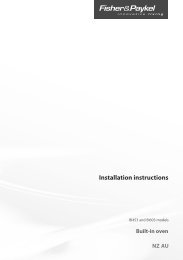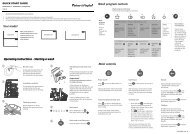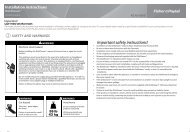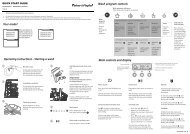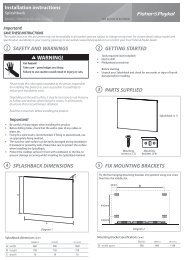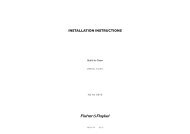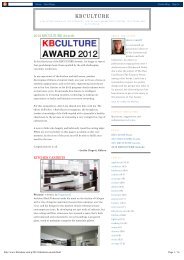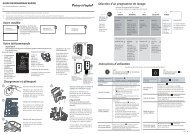Installation instructions and User guide - Fisher & Paykel
Installation instructions and User guide - Fisher & Paykel
Installation instructions and User guide - Fisher & Paykel
Create successful ePaper yourself
Turn your PDF publications into a flip-book with our unique Google optimized e-Paper software.
QuickSmart <strong>and</strong> WashSmart<br />
Clothes washer<br />
<strong>Installation</strong> <strong>instructions</strong><br />
<strong>and</strong> <strong>User</strong> <strong>guide</strong><br />
NZ AU PAC SG
Intelligence working for you<br />
Your washer is born from 75 years of <strong>Fisher</strong> & <strong>Paykel</strong> laundry innovation. Unlike conventional<br />
machines, <strong>Fisher</strong> & <strong>Paykel</strong> clothes washers, through Smart Drive technology adapt the wash<br />
action <strong>and</strong> water levels to save on water <strong>and</strong> electricity use; making it kinder on your wallet <strong>and</strong><br />
the environment.<br />
Intelligent electronics<br />
A powerful microprocessor controls every aspect of<br />
your machine, allowing it to continually monitor <strong>and</strong><br />
respond to each wash. This intelligence is the result of<br />
many years of testing <strong>and</strong> fine-tuning, giving you the<br />
best possible performance.<br />
Direct drive motor<br />
Our revolutionary direct drive motor is capable of<br />
infinite wash actions, continuously adjusting its speed<br />
to the movement of your clothes, removing dirt while<br />
caring for the fabric, delivering the ultimate wash.<br />
Reliability<br />
Your washer has no mechanical brake, pulleys or<br />
gears, which means fewer moving parts <strong>and</strong> greater<br />
reliability.<br />
Saves time<br />
With a top spin speed of 1000 rpm, your washer<br />
reduces clothes drying time by up to 30%.<br />
Energy conservation<br />
The unique wash action means a typical load uses<br />
only the same amount of electricity as a 100-watt<br />
light bulb left on for an hour.<br />
Eco<br />
Designed to make every drop count, using up to 25%<br />
less water than a traditional rinse.
Contents<br />
<strong>Installation</strong> Instructions 2<br />
Getting started<br />
Before you do your first wash 5<br />
Using your WashSmart washer 6<br />
Using your QuickSmart washer 8<br />
Lid lock 10<br />
Wash cycles <strong>and</strong> options<br />
Wash cycles 11<br />
Selecting wash options <strong>and</strong> advancing the cycle 12<br />
Water levels 13<br />
Saving water & time – Eco & Quick Wash options 14<br />
Wash options - Soak, Spin Hold, Delay Start options 15<br />
Washing bulky items, Washing woollens 16<br />
Favourite cycle 17<br />
Customising the wash cycles 18<br />
Before you wash<br />
Sorting, Loading 19<br />
Detergent 20<br />
Fabric softener, Scrud 21<br />
Changing pre-set options<br />
Option adjustment mode 22<br />
Wash temperatures, Rinse options 24<br />
Controlled cold, End of cycle beeps, Auto water fill level 25<br />
Out of balance recovery routine 26<br />
Machine information<br />
Specifications 26<br />
Caring for your washer 27<br />
Additional information 28<br />
Saving water 29<br />
Problem solving<br />
If your washer beeps for help 31<br />
Operating problems 33<br />
Wash problems 34<br />
Manufacturer’s Warranty 36<br />
Customer Care 38<br />
Important!<br />
SAVE THESE INSTRUCTIONS<br />
The models shown in this <strong>User</strong> Guide may not be available in all markets <strong>and</strong> are<br />
subject to change at any time. For current details about model <strong>and</strong> specification<br />
availability in your country, please visit our local website listed on the back cover<br />
or contact your local <strong>Fisher</strong> & <strong>Paykel</strong> dealer.<br />
1
2 <strong>Installation</strong> <strong>instructions</strong><br />
Unpacking<br />
To ensure the best performance from your new<br />
washer please follow the <strong>instructions</strong> below.<br />
Removing the packaging<br />
1 Remove the outer packaging.<br />
2 Tilt the machine backwards <strong>and</strong> walk it off the bottom<br />
packer one foot at a time.<br />
3 Remove the bottom packer from under the machine by<br />
pulling it out the front.<br />
4 Lift the lid <strong>and</strong> remove the bowl packer from the bowl.<br />
5 Remove the hoses <strong>and</strong> accessories.<br />
6 Keep the bottom packer <strong>and</strong> bowl packer in case they<br />
are required for future transit.<br />
Fig.1 Tilt washer backwards to remove packer<br />
Important!<br />
Please ensure that the bottom packer has been removed before operating your machine.<br />
Location<br />
Your washer must be installed on a level surface, <strong>and</strong> not on any textured floor coverings<br />
(eg carpet, rugs) to ensure that the opening at the bottom of the machine is not obstructed.<br />
In your clothes washer you will find:<br />
1 hose <strong>guide</strong>.<br />
2 inlet hoses.<br />
Drain hose<br />
1 Carefully pull the drain hose out from the back<br />
of the machine by pulling the exposed part of<br />
the hose downward <strong>and</strong> outward.<br />
2 To <strong>guide</strong> the drain hose over the tub or<br />
st<strong>and</strong>pipe the hose <strong>guide</strong> MUST be fitted to the<br />
drain hose.<br />
To prevent syphoning:<br />
The drain hose should not extend more than<br />
20 mm from the end of the <strong>guide</strong>.<br />
The height of the st<strong>and</strong>pipe or tub should be<br />
between 850 – 1200 mm.<br />
The drain hose can be trimmed to length.<br />
3 Place the drain hose in the tub or st<strong>and</strong>pipe.<br />
Pull hose<br />
through <strong>guide</strong><br />
Flex hose<br />
<strong>guide</strong> apart<br />
St<strong>and</strong>pipe 850 – 1200 mm<br />
Fig.2 Fitting the drain hose <strong>guide</strong><br />
(20 mm)<br />
maximum
<strong>Installation</strong> <strong>instructions</strong><br />
1<br />
Inlet hoses<br />
Note: new hose sets provided with the machine are to be used to connect<br />
the washer to the water mains. Old hose sets should not be re-used.<br />
Connect the straight ends of the inlet hoses to the taps (there are washers<br />
fitted in both ends). Connect the red connector hose to hot, <strong>and</strong> the white<br />
connector hose to cold (if your hoses are colour-coded).<br />
2 Connect the elbow ends of the inlet hoses to the corresponding machine<br />
inlet valves.<br />
Inlet valves are marked on the back of the machine.<br />
Tap end Machine end<br />
Fig.3 Inlet hose ends<br />
H = Hot C = Cold<br />
Minimum height of taps to clear the top of the machine is 1150 mm.<br />
Cold supply only:<br />
If you only have a cold water supply, an inlet valve cap (blanking cap) MUST be connected to<br />
the hot inlet valve. The cap prevents water leaking out of the hot valve. The cap is available from<br />
your <strong>Fisher</strong> & <strong>Paykel</strong> Dealer or Authorised Repairer, Part No. 388491P. This appliance incorporates<br />
backflow protection complying with AS3500.1. No further backflow protection is required for<br />
connection to the water supply.<br />
Note: your washer does not have an internal heater to heat water.<br />
Inlet hose replacement<br />
We recommend replacing the inlet hoses every 5 years. Hoses should be checked from time to<br />
time <strong>and</strong> replaced if any wear, cuts, bulges, kinks or leaks are found.<br />
Levelling your machine<br />
It is IMPORTANT to level the machine to ensure even spin<br />
performance.<br />
1 Separate the 4 rubber foot inserts from the moulding <strong>and</strong> fit<br />
into the feet on the base of the machine.<br />
2 Move the machine to its final position (we suggest a minimum<br />
clearance of 20 mm each side).<br />
3 Adjust the feet (wind down) so the machine is level <strong>and</strong> cannot rock.<br />
To check if your machine is level:<br />
Look down on the wash bowl <strong>and</strong> make sure it sits slightly forward of centre (see Diagram 1).<br />
Close the lid. Visually check that the lid fits evenly on both sides. If it does not look like the<br />
diagram in the middle, adjust one of the feet slightly until it matches. The diagram on the top<br />
<strong>and</strong> bottom are not correct (see Diagram 2).<br />
Diagram 1<br />
Wind left foot down<br />
(out) to correct<br />
Lid alignment<br />
Lid<br />
Diagram 2<br />
Correct<br />
Incorrect<br />
To check levelling look<br />
down on the wash bowl<br />
Wind right foot down<br />
(out) to correct<br />
Topdeck Lid<br />
Topdeck<br />
Lid<br />
Topdeck<br />
Fig.5 To assess levelling, check lid alignment<br />
Adjustable feet<br />
Corner cabinets<br />
Rubber insert<br />
Fig.4 Adjusting the levelling feet<br />
4 Turn on the water <strong>and</strong> check all hose connections for leaks. Check for leaks again after 24 hours.<br />
Make sure there are no kinks in the hoses.<br />
5 Uncoil the power cord, remove <strong>and</strong> discard the plastic pin cover, <strong>and</strong> plug into the wall socket.<br />
3
4<br />
<strong>Installation</strong> <strong>instructions</strong><br />
Water supply<br />
Your cold water should not exceed 35°C <strong>and</strong> your RMC TVA 50HF<br />
hot water should not exceed 65°C. Temperatures<br />
above these may cause the machine to fault or<br />
cause damage to the machine.<br />
If you have an uncontrolled water heating source<br />
(eg a wet back or solar heating system) you should<br />
fit a Safe Valve. This will ensure the hot water<br />
temperature remains within safe limits.<br />
Inlet water pressure: Max.1 MPa (150 psi) Min. 34 Pa (5 psi)<br />
Inlet water flow rate: Min. 3 litres/min<br />
Minimum height of taps to clear the top of the machine is 1150 mm.<br />
Draining<br />
Regularly check that your st<strong>and</strong>pipe or tub is free from lint or other obstructions, which may<br />
affect how your machine works or may cause flooding.<br />
In multi-storey apartments or any upper floor, the machine should be installed on a drained floor.<br />
Draining must comply with local by-laws.<br />
Clothes washer safety<br />
This clothes washer is not intended for use by children <strong>and</strong> persons with reduced physical,<br />
sensory or mental capabilities, or lack of experience <strong>and</strong> knowledge, unless they have been given<br />
supervision or instruction concerning use of the appliance by a person responsible for their safety.<br />
Your washer can be opened while it is filling <strong>and</strong> agitating. Supervise children at all times to<br />
ensure they do not play with the washer.<br />
WARNING!<br />
Hot ‘N’ Safe Valves available are:<br />
RMC TVA 75HFS<br />
Adjustable between 35°C – 55°C<br />
RMC TVA 50HP<br />
For instantaneous gas hot water supply<br />
Electrical Shock Hazard<br />
If you are using an extension cord or a portable electrical outlet device<br />
(eg multi-socket outlet box), ensure that it is positioned so that it does<br />
not come into contact with water or moisture.<br />
Failure to do so may result in death or electrical shock.<br />
Accessories <strong>and</strong> spare parts<br />
Available from your <strong>Fisher</strong> & <strong>Paykel</strong> Dealer or Authorised Repairer.<br />
Inlet Valve Cap Part No. 388491P<br />
Hose Inlet Long (2m) Part No. 422680P<br />
Hose Inlet Large Bore Part No. 426123P<br />
Drain Hose Extension Part No. 425627P<br />
Power Cord If the power cord of your clothes washer is damaged it must be replaced<br />
by a <strong>Fisher</strong> & <strong>Paykel</strong> Authorised Repairer, as it is not a st<strong>and</strong>ard power cord.
Getting started<br />
Thank you for buying a <strong>Fisher</strong> & <strong>Paykel</strong> washing machine. We are very proud of this washer <strong>and</strong><br />
trust it will serve you well for many years.<br />
At <strong>Fisher</strong> & <strong>Paykel</strong> we aim to provide innovative products that are simple to use, ergonomic <strong>and</strong><br />
energy efficient. Thous<strong>and</strong>s of tonnes of washing <strong>and</strong> 75 years of laundry experience have been<br />
programmed into your washing machine to help give you the best possible performance.<br />
We hope you enjoy your new washing machine. We have certainly enjoyed designing it.<br />
Before you do your first wash<br />
You owe it to yourself <strong>and</strong> your washer to have it installed correctly by a technician from a<br />
<strong>Fisher</strong> & <strong>Paykel</strong> Authorised Repairer.<br />
Before you start, it is a good idea to go through the following checklist:<br />
1 Has the basepacker been removed?<br />
2 Is the hot hose connected to the hot valve marked ‘H’? Is the cold hose connected to the cold<br />
valve marked ‘C’?<br />
3 Is the drain hose threaded through the ‘U bend‘ (with no more than 20 mm extended) <strong>and</strong> on to<br />
your st<strong>and</strong>pipe?<br />
4 Are the rubber inserts secured into the feet on the base of your machine <strong>and</strong> is the machine<br />
levelled? Refer to ‘<strong>Installation</strong> <strong>instructions</strong>’, page 3.<br />
If you have bought a QuickSmart model it is a good idea to check the warm fill temperature<br />
(refer to page 24).<br />
Fig.6 WashSmart washer Fig.7 QuickSmart washer<br />
5
6 Using your WashSmart washer<br />
Place the load evenly around the agitator (refer to ‘Sorting’ <strong>and</strong> ‘Loading’, page 19).<br />
Remove fabric softener dispenser.<br />
A. Detergent<br />
Follow the <strong>instructions</strong> on the detergent package.<br />
Use the mark on the agitator, nearest to the top of<br />
the clothes, as a <strong>guide</strong> to the correct amount<br />
of detergent to use (refer to ‘Detergent’, page 20).<br />
Pour the detergent down the centre of the<br />
agitator stem.<br />
Replace the fabric softener dispenser (this stops<br />
small articles falling down the centre of the agitator).<br />
WashSmart – WA80T65G, WA70T60G, WA55T56G, WA10T65G, WA85T60G, WA75T56G<br />
B. Fabric softener<br />
If you wish to use fabric softener, place it in the<br />
dispenser on the top of the agitator (refer to page 21).<br />
Important!<br />
Fabric softener must not be used if you have selected<br />
the ECO or QUICK WASH option (refer to page 14).<br />
C<br />
D
C. Power<br />
Press POWER to turn the machine on.<br />
D. Wash cycles<br />
Select the desired wash cycle by pressing the button.<br />
E. Wash options<br />
Using your WashSmart washer<br />
Select the WASH TEMPERATURE, WATER LEVEL, SPIN SPEED <strong>and</strong> other wash options (refer to<br />
pages 12 – 15).<br />
F. Advance<br />
Use to advance through to the desired part of the wash cycle (refer to page 12).<br />
F<br />
G. Start<br />
E<br />
Press START/PAUSE to start the machine.<br />
If you wish to stop your WashSmart washer<br />
Press START/PAUSE.<br />
If it is during spray rinse or spin there is a slight delay while the bowl slows to a stop <strong>and</strong> the lid<br />
is unlocked.<br />
Important!<br />
For best fabric <strong>and</strong> colour care remove your clothes as soon as the cycle has finished.<br />
G<br />
7
8 Using your QuickSmart washer<br />
Place the load evenly around the agitator (refer to ‘Sorting’ <strong>and</strong> ‘Loading’, page 19).<br />
Remove fabric softener dispenser.<br />
A. Detergent<br />
Follow the <strong>instructions</strong> on the detergent package.<br />
Use the mark on the agitator, nearest to the top of<br />
the clothes, as a <strong>guide</strong> to the correct amount<br />
of detergent to use (refer to ‘Detergent’, page 20).<br />
Pour the detergent down the centre of the<br />
agitator stem.<br />
Replace the fabric softener dispenser (this stops<br />
small articles falling down the centre of the agitator).<br />
QuickSmart – WA65T60M (MW613), WA55T56M (MW513), WA75T56M (MWC12)<br />
B. Fabric softener<br />
If you wish to use fabric softener, place it in the<br />
dispenser on the top of the agitator (refer to page 21).<br />
Important!<br />
Fabric softener must not be used if you have selected<br />
the ECO option (refer to page 14).<br />
C<br />
D
F<br />
C. Power<br />
Press POWER to turn the machine on.<br />
D. Wash cycles<br />
Using your QuickSmart washer<br />
Select the cycle you want by pressing the SMART TOUCH CYCLES button located below the<br />
REGULAR option. Scroll through the cycles until the light for the one you want is lit.<br />
E. Wash options<br />
Select the WASH TEMPERATURE, WATER LEVEL, SPIN SPEED <strong>and</strong> other wash options (refer to<br />
pages 12 – 15).<br />
F. Advance<br />
Use to advance through to the desired part of the wash cycle (refer to page 12).<br />
E<br />
G. Start<br />
Press START/PAUSE to start the machine.<br />
If you wish to stop your QuickSmart washer<br />
G<br />
Press START/PAUSE.<br />
If it is during spray rinse or spin there is a slight delay while the bowl slows to a stop <strong>and</strong> the lid<br />
is unlocked.<br />
Important!<br />
For best fabric <strong>and</strong> colour care remove your clothes as soon as the cycle has finished.<br />
9
10 Lid lock<br />
Your washer has a lid lock, which locks when<br />
your machine is spinning. This ensures the lid<br />
cannot be opened during hazardous parts of<br />
the cycle, providing added safety for you <strong>and</strong><br />
your family.<br />
The LID LOCK light (above the START/PAUSE<br />
button) comes on when the lid is locked to tell<br />
you when you cannot open the lid. In short it<br />
means you can open the lid while your washer<br />
is filling, agitating <strong>and</strong> draining, but not while it<br />
is spinning.<br />
When the LID LOCK light is on, the lid is locked.<br />
When the LID LOCK light is off, the lid is not<br />
locked <strong>and</strong> the lid can be opened.<br />
If the LID LOCK light is flashing, the lid lock is<br />
in the process of locking or unlocking (ie while<br />
QuickSmart<br />
the machine’s bowl slows down or START/PAUSE<br />
has been pressed). During this stage the lid still<br />
Fig.8 LID LOCK light<br />
cannot be lifted.<br />
Important!<br />
If the lid is left open, the machine will be unable to lock <strong>and</strong> the cycle will be halted.<br />
The machine will play a tune <strong>and</strong> the LID LOCK light will flash until the lid is closed <strong>and</strong><br />
START/PAUSE is pressed.<br />
The lid lock remains unlocked for the majority of the cycle allowing you to add clothes,<br />
dissolve detergent or to add fabric softener (if you do not want to use the Automatic Fabric<br />
Softener Dispenser).<br />
The chart below shows the stages when<br />
the lid is locked.<br />
Fill Unlocked<br />
Agitate Unlocked<br />
Spray Rinse Locked<br />
Deep Rinse Unlocked<br />
Spin Locked<br />
WashSmart<br />
Fig.9 Lid lock<br />
Important!<br />
Keep children away from the machine, especially when you are using hot water, as the lid can<br />
be opened during fill <strong>and</strong> agitate.<br />
DO NOT put anything down the lid lock slot in the top deck of your machine.<br />
DO NOT try to disable the lid lock.
Default settings<br />
WashSmart model<br />
Wash cycles <strong>and</strong> options<br />
REGULAR HEAVY DUTY HAND WASH ALLERGY EASY IRON<br />
Wash time 12 min 15 min 6 min 12 min 9 min<br />
Wash action REGULAR HEAVY DUTY HAND WASH REGULAR REGULAR<br />
Wash temp* WARM/COLD WARM WARM/COLD HOT WARM/COLD<br />
Rinse<br />
Spray rinse<br />
+ cold<br />
deep rinse<br />
Spray rinse<br />
+ cold<br />
deep rinse<br />
2 cold<br />
deep<br />
rinses<br />
2 cold<br />
deep<br />
rinses<br />
2 cold<br />
deep<br />
rinses<br />
Spin speed FAST FAST SLOW FAST SLOW<br />
Spin time 6 min 6 min 4 min 6 min 2 min<br />
*For users in markets with cold supply only, the wash temperature will default to cold.<br />
QuickSmart model<br />
REGULAR HEAVY DUTY DELICATE WOOL<br />
Wash time 12 min 15 min 6 min 6 min<br />
Wash action REGULAR HEAVY DUTY DELICATE DELICATE<br />
Wash temp* WARM WARM WARM WARM<br />
Rinse<br />
Spray rinse<br />
+ cold<br />
deep rinse<br />
Spray rinse<br />
+ cold<br />
deep rinse<br />
2 cold<br />
deep<br />
rinses<br />
Spray rinse<br />
+ cold<br />
deep rinse<br />
Spin speed FAST FAST SLOW MEDIUM<br />
Spin time 6 min 6 min 4 min 6 min<br />
*For users in markets with cold supply only, the wash temperature will default to cold.<br />
Model variations<br />
WashSmart model – Fully featured, with REGULAR, HEAVY DUTY, HAND WASH, ALLERGY <strong>and</strong><br />
EASY IRON cycles, <strong>and</strong> a FAVOURITE cycle.<br />
QuickSmart model – REGULAR, HEAVY DUTY, DELICATE <strong>and</strong> WOOL cycles.<br />
Basic cycle descriptions<br />
REGULAR cycle (with the ECO option) has been designed for normally soiled, everyday washing,<br />
eg sheets, towels, T-shirts.<br />
HEAVY DUTY cycle is for heavily soiled durable garments, eg overalls, jeans, tea towels.<br />
HAND WASH cycle is designed for your most delicate garments <strong>and</strong> is recommended for all<br />
“H<strong>and</strong> wash only” items.<br />
ALLERGY cycle has been designed for those with skin <strong>and</strong> other sensitivities.<br />
EASY IRON cycle is for items susceptible to creasing, eg shirts, dress trousers.<br />
DELICATE cycle uses a slow, gentle agitation designed to care for your delicate items, eg lingerie,<br />
blouses.<br />
WOOL cycle is for machine washable woollens.<br />
11
12<br />
Wash options <strong>and</strong> advancing the cycle<br />
To select the wash options<br />
WashSmart model<br />
1 Select the wash cycle, temperature, water<br />
level <strong>and</strong> spin speed (refer to page 7).<br />
2 Press the OPTIONS button if you want to<br />
choose ECO, SOAK or QUICK WASH (refer to<br />
pages 14 <strong>and</strong> 15).<br />
3 Press START/PAUSE.<br />
QuickSmart model<br />
1 Select the wash cycle, temperature, water<br />
level <strong>and</strong> spin speed (refer to page 9).<br />
2 If you wish to save water press the ECO<br />
option button (refer to page 14).<br />
3 Press START/PAUSE.<br />
The wash progress lights<br />
The wash progress lights show all the tasks<br />
your washer will do during the wash cycle.<br />
As each task is completed a light goes out,<br />
so you can tell at a glance how far the cycle<br />
has to go.<br />
To advance the wash cycle<br />
1 Press the button with the ‘two arrows’ repeatedly<br />
to advance the cycle to the desired position.<br />
2 Press START/PAUSE.<br />
Note: each wash progress light equals 3 minutes of<br />
agitation. The ECO option wash progress lights may in<br />
some cases wash for longer. This is dependent on the water<br />
level. The QUICK WASH option shortens the agitation time<br />
for each progress light (WashSmart model only).<br />
Clothes care safeguards<br />
WashSmart<br />
QuickSmart<br />
Fig.10 Selecting wash options<br />
Fig.11 Wash progress lights<br />
Note: while WashSmart model is shown, setting of the<br />
QuickSmart model is identical<br />
WashSmart<br />
QuickSmart<br />
Fig.12 Advancing the wash cycle<br />
To avoid accidentally damaging your clothes there are a few options that your washer will not<br />
accept. For example, you cannot select a HOT wash on the HAND WASH or EASY IRON cycles<br />
(WashSmart model) <strong>and</strong> DELICATE or WOOL cycles (QuickSmart model), nor can you select the<br />
ECO option on anything other than the HEAVY DUTY or REGULAR cycles (both models).
Manual water level selection<br />
The agitator has five levels marked on its stem that<br />
can be used to help you select the correct water<br />
level. Select the correct water level by using the<br />
mark nearest to the top of the load.<br />
The levels marked on the agitator do not correspond<br />
exactly to the level of the water. They indicate the<br />
level of dry clothes suitable for the water level.<br />
Your washer may occasionally add water during<br />
agitation. This is to maintain the water level due to<br />
the release of air trapped in the garments.<br />
The medium/high <strong>and</strong> medium/low settings are<br />
available on the WashSmart model only.<br />
Out of balance loads, tangling or splash-over can be<br />
caused by selecting a water level that is too high.<br />
Auto water level<br />
WashSmart model only<br />
Your washer can automatically select the appropriate<br />
water level for the load.<br />
1 Place your clothes in the machine.<br />
2 Select the wash cycle (<strong>and</strong> select AUTO water level if<br />
not automatically selected).<br />
3 Press START/PAUSE.<br />
During fill, the machine will pause occasionally to<br />
sense the water level. The machine will check if<br />
the water level is correct by using a series of two<br />
different agitate strokes. A slow stroke to sense the<br />
load <strong>and</strong> an agitate stroke to mix the load. (This<br />
may take over a minute.) If the machine detects that<br />
the water level is not high enough, it will add more<br />
water <strong>and</strong> re-check the level.<br />
When washing an unusual load, eg large bulky<br />
garments or pillows, we recommend you manually<br />
select the water level <strong>and</strong> select the HAND WASH<br />
cycle (WashSmart model) or the DELICATE cycle<br />
(QuickSmart model).<br />
If there is already water in the bowl, it is best to<br />
manually select the water level.<br />
Water levels<br />
Fig.13 Water level <strong>guide</strong> on agitator<br />
Fig.14 Selecting AUTO water level<br />
Note: if you feel the AUTO water level does not fill to the correct level, you can adjust the level<br />
the machine selects (refer to ‘Changing pre-set options’, pages 22 <strong>and</strong> 25).<br />
13
14 Wash options – saving water <strong>and</strong> time<br />
Eco<br />
WashSmart <strong>and</strong> QuickSmart models<br />
Use the ECO option to save water. The ECO option uses an<br />
Eco Spray rinse which has been specially designed to use<br />
at least 25% less water than a traditional rinse. Use this<br />
option when you want to use less detergent <strong>and</strong> less water.<br />
However, if you have low water pressure or sensitive skin it<br />
is better to use a traditional rinse.<br />
The ECO option has not been designed to be used with<br />
fabric softener, as it does not have a second deep rinse to<br />
dispense the softener correctly. Fabric softener should not<br />
be used if this option is selected.<br />
Note: the ECO option is only available on the REGULAR <strong>and</strong><br />
HEAVY DUTY cycles. If you try to select this option on the<br />
HAND WASH, ALLERGY or EASY IRON cycles (WashSmart<br />
model), or the WOOL or DELICATE cycles (QuickSmart<br />
model), your washer will skip over the option. ECO will take<br />
slightly longer than a normal spray <strong>and</strong> deep rinse.<br />
There are some wash loads that may not suit being<br />
washed using the ECO option. For instance, loads that have<br />
a lot of s<strong>and</strong> or sawdust in them or garments where the<br />
colour still runs from them.<br />
Quick wash<br />
WashSmart model only<br />
Our WashSmart model provides an excellent opportunity<br />
to save time. Use the QUICK WASH option to halve the wash<br />
time during the REGULAR, HEAVY DUTY, HAND WASH or<br />
EASY IRON wash cycles. We recommend using the QUICK<br />
WASH option for lightly soiled loads.<br />
Note: when the QUICK WASH <strong>and</strong> SOAK options are<br />
selected at the same time, the soak time will also be halved.<br />
The QUICK WASH option has not been designed to be used<br />
with fabric softener as it does not have a second deep rinse<br />
to dispense the softener correctly. Fabric softener should<br />
not be used if this option is selected.<br />
WashSmart<br />
QuickSmart<br />
Fig.15 Selecting the ECO option<br />
WashSmart<br />
Fig.16 Selecting the QUICK WASH<br />
option
Soak<br />
WashSmart model only<br />
Use the SOAK option to soak clothes at the end of the wash<br />
phase or when you wish to re-use the wash water.<br />
When you select SOAK your washer will soak for a period of<br />
2 hours before completing RINSE <strong>and</strong> SPIN. During SOAK your<br />
washer will agitate for a few seconds every minute.<br />
Note: when both the SOAK <strong>and</strong> QUICK WASH options are<br />
selected, the soak time will be halved.<br />
Nappy sanitisers/bleach<br />
Wash options<br />
Nappy sanitisers <strong>and</strong> bleach are very corrosive to metal<br />
surfaces. These should not be used in your machine.<br />
Important!<br />
DO NOT use your washer to soak items in bleach or sanitiser, <strong>and</strong> if you’ve soaked items in a bucket,<br />
do not tip the contents of the bucket into your machine. The chemicals in these products can<br />
damage your washer. Rinse <strong>and</strong> wring items out thoroughly before placing them in your machine.<br />
Spin Hold<br />
WashSmart & QuickSmart model<br />
Use the SPIN HOLD option to:<br />
Remove drip dry garments from a mixed load before the wash<br />
goes into SPIN.<br />
Minimise the clothes creasing when they are left to sit in the<br />
bottom of the bowl at the end of the cycle.<br />
When you have selected SPIN HOLD, the washer will pause at<br />
the end of RINSE, beep <strong>and</strong> the SPIN light will flash to tell you<br />
that it is waiting for another instruction.<br />
Press START/PAUSE to begin the spin.<br />
Delay Start<br />
WashSmart model only<br />
DELAY START will delay the start of the wash cycle for 1, 3 or<br />
9 hours.<br />
Press DELAY START once for a delay of 1 hour. Press again for<br />
3 hours, a third time for 9 hours (<strong>and</strong> again to return to normal).<br />
Once you press DELAY START your washer will begin the delay<br />
period. You do not have to press START/PAUSE.<br />
Be careful if using DELAY START for non-colourfast clothes as<br />
dyes may run if the clothes are damp.<br />
Your washer will not beep at the end of the cycle if DELAY<br />
START is selected.<br />
WashSmart<br />
Fig.17 Selecting the SOAK option<br />
15<br />
Fig.18 Selecting the SPIN HOLD<br />
option<br />
Note: while WashSmart model is<br />
shown, setting of the QuickSmart<br />
model is identical<br />
Fig.19 Selecting DELAY START
16 Wash options<br />
Washing bulky items<br />
Forcing large items into the machine may result in<br />
them being damaged during washing. Make sure<br />
there is enough room in the machine for items to<br />
move when being washed.<br />
Some items float up during the wash (eg duvets/<br />
doonas <strong>and</strong> pillows). If they sit too high they may<br />
touch stationary parts of the machine during<br />
agitate or spin. To minimise the chance of this<br />
happening, bulky items should be pushed down<br />
below the water level after fill <strong>and</strong> pushed to sit<br />
below the medium high water level mark on the<br />
agitator before spinning. Select a SLOW spin.<br />
Important!<br />
To prevent an out of balance load or splash-over we recommend washing bulky items on the<br />
HAND WASH cycle (WashSmart model) or the DELICATE cycle (QuickSmart model).<br />
If you wish to re-spin the load at a faster speed make sure the load is sitting below the<br />
medium-high mark before spinning.<br />
Washing woollens<br />
Many woollen items carry a MACHINE WASHABLE care<br />
claim. The fibres of these woollens have been treated<br />
to prevent felting when they are machine washed.<br />
Fig.20 Bulky items should sit below the<br />
medium high water level mark.<br />
Check the care label.<br />
Use a wool detergent.<br />
Use the specially designed HAND WASH cycle (WashSmart model) or WOOL cycle<br />
(QuickSmart model). For your more durable woollens you may want to use the EASY IRON cycle<br />
(WashSmart model only).<br />
H<strong>and</strong> washed woollens may be spun in your washer (select SLOW spin speed).<br />
To dry woollens lie them flat on a towel <strong>and</strong> pat into shape. Dry out of direct sunlight.<br />
Most h<strong>and</strong>crafted garments are not made of machine washable wool <strong>and</strong> we recommend that<br />
you wash them by h<strong>and</strong> only.<br />
Note: some wool underlays <strong>and</strong> sheepskin products can be washed in a washing machine but<br />
could produce excessive amounts of lint that may cause pump blockages.
FAVOURITE cycle<br />
Favourite cycle<br />
WashSmart model only<br />
The FAVOURITE cycle lets you programme your ideal wash cycle. It can be any wash cycle with<br />
any of its wash options <strong>and</strong> it can start from any point in the cycle. For instance, it may be a<br />
cycle to wash your gym gear or it may be a rinse <strong>and</strong> spin to finish washing the nappies.<br />
To set your favourite cycle<br />
1 Press POWER.<br />
2 Press the FAVOURITE cycle button. Hold down for 2 seconds.<br />
3 You will hear 2 quick beeps <strong>and</strong> the FAVOURITE light will flash.<br />
4 Select your preferred (‘favourite’) cycle, eg REGULAR, ALLERGY.<br />
5 Select the wash options, eg COLD wash, SOAK. Use ADVANCE if you want part of a cycle<br />
(eg to rinse nappies).<br />
6 Press FAVOURITE again to store your favourite cycle.<br />
To change your FAVOURITE cycle simply repeat these steps.<br />
Note: your washer will remember your FAVOURITE cycle even when it is turned off at the wall. It<br />
is not possible to program a delayed start into the FAVOURITE cycle.<br />
To use your favourite cycle<br />
1 Press POWER.<br />
2 Press FAVOURITE.<br />
(Your favourite cycle <strong>and</strong> wash options<br />
will be automatically selected).<br />
3 Press START/PAUSE.<br />
Fig.21 The FAVOURITE cycle<br />
17
18 Customising the wash cycles<br />
To customise a cycle<br />
WashSmart model only<br />
You can program your washer to remember the wash options you prefer for each wash cycle. For<br />
instance, you may want to set the REGULAR cycle to a COLD wash or set HEAVY DUTY to include<br />
a SOAK.<br />
1 Press POWER.<br />
2 Press the wash cycle button. Hold down for 2 seconds.<br />
You will hear 2 quick beeps <strong>and</strong> the wash cycle light will flash.<br />
3 Select your wash options, eg COLD wash, SOAK.<br />
4 Press the wash cycle again to store your customised cycle.<br />
To change your customised wash cycle simply repeat these steps.<br />
When you are customising a wash cycle you can shorten or lengthen the wash time.<br />
To shorten the wash time, press the ADVANCE button to reduce the number of wash progress<br />
lights that are illuminated.<br />
To increase the wash time keep pressing the ADVANCE button until all the wash progress lights<br />
are illuminated (see page 12).<br />
Note: unlike the FAVOURITE cycle you cannot customise a wash cycle to start at the RINSE or<br />
SPIN stage. On HEAVY DUTY <strong>and</strong> HAND WASH you can only decrease the wash time.<br />
Fig.22 Customising a wash cycle
Sorting<br />
To get the best wash results it pays to sort your<br />
clothes before washing.<br />
Care labels<br />
The care label will tell you about the fabric of the<br />
garment <strong>and</strong> how it should be washed.<br />
Soil<br />
Sort clothes according to the type <strong>and</strong> amount<br />
of soil. Some soils suit warmer washes, eg oily<br />
soils, while others are best washed in cold water,<br />
eg mud, blood.<br />
Colour<br />
Sort white fabrics from coloured fabrics.<br />
Lint<br />
Wash lint givers <strong>and</strong> lint collectors separately.<br />
Where possible, turn lint collectors inside out.<br />
Loading<br />
Before you wash<br />
Machine Washable<br />
Warm 40°C max<br />
Warm Rinse Well<br />
Normal Spin<br />
Do not bleach<br />
Do not tumble dry<br />
Dry in shade<br />
Warm iron<br />
Dry Cleanable<br />
Examples of different care label symbols.<br />
Check pockets<br />
Loose items can damage both your washer <strong>and</strong><br />
Lint givers Lint collectors<br />
your clothes.<br />
Towels Synthetics<br />
Close zippers, hooks <strong>and</strong> eyes<br />
Chenille Corduroy<br />
This is to make sure that these items do not snag Nappies Poly cotton<br />
on other clothes.<br />
Mend any torn garments or loose buttons<br />
Tears or holes may become larger during<br />
washing. Remove any loose bra wires as they can<br />
damage your washing machine <strong>and</strong>/or dryer.<br />
Pretreat any stains<br />
Socks<br />
Make sure you use an appropriate surface to apply treatments. Do not use the lid or top of the<br />
machine, as damage may occur to these surfaces.<br />
Make sure the water level suits the load size<br />
Select the correct water level by using the mark on the agitator nearest to the top of the load.<br />
Ensure that the load does not extend above the fabric softener dispenser, as splashing may occur.<br />
For a balanced load<br />
Place unfolded clothes firmly <strong>and</strong> evenly around the agitator.<br />
Do not wrap large items, such as sheets, around the agitator.<br />
A mixture of small <strong>and</strong> large items will wash the best.<br />
Important!<br />
Please do not, under any circumstances, attempt to wash an electric blanket in your washer. Nor is<br />
it recommended that you wash curtains in your washer. Sunlight makes them brittle <strong>and</strong> they may<br />
disintegrate during washing.<br />
19
20 Detergent<br />
Choosing the right detergent<br />
We recommend using domestic detergent.<br />
You can use powder or liquid.<br />
Soap flakes or granulated soap powders<br />
should not be used in your washer.<br />
When washing wool items, remember to<br />
use a detergent specifically recommended<br />
for woollens.<br />
How much detergent?<br />
Use the <strong>instructions</strong> on the back of the<br />
detergent packet as a <strong>guide</strong> to the correct<br />
amount of detergent to use. The correct<br />
amount of detergent will vary, depending<br />
on the amount of soil in your clothes <strong>and</strong><br />
the size of your load. Jeans <strong>and</strong> work clothes<br />
may need more detergent, while towels<br />
usually need less. The larger your machine,<br />
the more detergent you may have to add.<br />
Adding the detergent<br />
Liquid or powdered detergents<br />
1 Remove the fabric softener dispenser.<br />
2 Pour liquid or powdered detergent down<br />
the centre of the agitator.<br />
Some detergents MUST be fully dissolved before adding to your machine to get the best wash<br />
results. Check the <strong>instructions</strong> on the detergent packet.<br />
Pre-dissolving detergent in warm water (before adding it to the machine) when washing in cold<br />
water can improve the performance of the detergent.<br />
3 Replace the fabric softener dispenser (this prevents small articles falling down the centre of<br />
the agitator).<br />
Fig.23 Adding your detergent<br />
Machine Compact<br />
Concentrate<br />
Medium Large<br />
Water level Number of scoops<br />
high 1 rounded 11⁄3 11⁄2<br />
med high 1 scant 1 heaped 11⁄3<br />
medium 3⁄4 1 scant 1<br />
med low 1⁄2 2⁄3 3⁄4<br />
low 1⁄3 1⁄3 1⁄2<br />
Machine Compact<br />
Liquid<br />
Medium Large<br />
Water level Number of caps<br />
high 1 cap 11⁄4 cap 11⁄2 cap<br />
med high 1 cap 1 cap 11⁄4 cap<br />
medium 3⁄4 cap 3⁄4 cap 1 cap<br />
med low 1⁄2 cap 1⁄2 cap 3⁄4 cap<br />
low 1⁄3 cap 1⁄3 cap 1⁄2 cap<br />
Note: to check what size your machine is, look<br />
on the back of the topdeck. The word “compact”,<br />
“medium” or “large” will be embossed.
How the fabric softener is dispensed<br />
Fabric softener<br />
The fabric softener goes into the dispenser on the top of the agitator. During the rinse the<br />
machine spins to release the fabric softener, delivering it down the agitator stem as the machine<br />
fills for the final deep rinse.<br />
Note: ECO <strong>and</strong> QUICK WASH options are not designed to be used with fabric softener. Cycles<br />
using these options do not use a deep rinse so the machine cannot dispense fabric softener<br />
correctly.<br />
How much fabric softener?<br />
The ring on the dispenser cup is a <strong>guide</strong> for the amount of<br />
fabric softener to add for a full load. Smaller loads require<br />
less fabric softener.<br />
Cleaning the dispenser<br />
When using fabric softener, rinse your dispenser at the end<br />
of each wash.<br />
1 Separate the cup from the dispenser body by pushing<br />
downward on the base of the cup.<br />
2 Rinse both parts of the dispenser using warm soapy water.<br />
Scrud<br />
Scrud is the name given to the waxy build-up that can occur within any washer when the fabric<br />
softener comes into contact with detergent. This build-up is not brought about by a fault in the<br />
machine. If scrud is allowed to build up in the machine, it can result in stains on your clothes<br />
<strong>and</strong>/or an unpleasant smell in your washer.<br />
If you wish to use fabric softener we recommend:<br />
Using fabric softener sparingly.<br />
When filling the dispenser, do not splash or overfill.<br />
Clean dispenser as soon as the cycle has finished.<br />
Clean your machine regularly (refer page 27).<br />
Cold water washing increases the chance of this build-up occurring. We recommend a WARM or<br />
HOT wash at regular intervals, eg approximately every 5th wash.<br />
Fabric softener of a thinner consistency is less likely to leave residue on the dispenser <strong>and</strong><br />
contribute to a build-up.<br />
21<br />
Fig.24 Push cup through dispenser<br />
with thumb to remove
22 Changing pre-set options<br />
Option adjustment mode<br />
After using your washer a number of times you may want to fine tune some of the options to<br />
suit your wash needs.<br />
There are a number of pre-set options, which can be altered.<br />
In the WashSmart model the following pre-set options can be changed:<br />
The wash temperatures.<br />
The RINSE option on HEAVY DUTY <strong>and</strong> REGULAR cycles.<br />
The COLD wash to CONTROLLED COLD.<br />
The number of beeps at the end of the cycle.<br />
The fill level selected by AUTO water level.<br />
The out of balance recovery routine.<br />
In the QuickSmart model the following pre-set options can be changed:<br />
The WARM wash temperature.<br />
The RINSE option on HEAVY DUTY, REGULAR <strong>and</strong> WOOL cycles.<br />
The out of balance recovery routine.<br />
To enter option adjustment mode<br />
1 Turn machine on at the wall but do not press POWER.<br />
Press START/PAUSE <strong>and</strong> hold down, then press POWER.<br />
You will hear two quick beeps <strong>and</strong> the machine will<br />
show an unusual pattern of lights.<br />
In this mode the lights are used to indicate the different<br />
options available.<br />
The diagram on page 23 shows how the lights relate to<br />
the options you can change.<br />
Pages 24 – 26 explain the different options in more detail.<br />
2 Use the buttons on the panel to make your changes to<br />
the pre-set options.<br />
3 Press POWER to return to normal mode.<br />
4 Your washer will automatically remember your changes.<br />
WashSmart<br />
Fig.25 Entering Option Adjustment mode<br />
Note: while WashSmart model is shown,<br />
setting of the QuickSmart model is<br />
identical
Changing pre-set options<br />
1 Enter the option adjustment mode (refer to page 22).<br />
2 The diagram below shows how the lights relate to the options you can change. It also shows<br />
what lights will be on when you first enter the option adjustment mode.<br />
Use this diagram to help you adjust the options on the WashSmart model.<br />
Fig.26 Option adjustment on the WashSmart model<br />
Use this diagram to help you adjust the options on the QuickSmart model.<br />
Fig.27 Option adjustment on the QuickSmart model<br />
3 Use the buttons on the panel to change the pre-set options.<br />
WashSmart<br />
Fig.28 Option adjustment selection<br />
Note: while WashSmart model is shown,<br />
setting of the QuickSmart model is identical<br />
23
24 Changing pre-set options<br />
Wash temperatures<br />
On the QuickSmart model the WARM temperature can be adjusted if you think it is too hot or<br />
too cold.<br />
Note: the hot temperature will be the same as the hot water supply temperature.<br />
On the WashSmart model all wash temperatures can be individually adjusted.<br />
1 Select the WASH TEMPERATURE you want to adjust.<br />
2 The wash progress lights show the temperature adjustment possible for that temperature.<br />
Pressing the ADVANCE button will cause the wash progress light that is on to change.<br />
Advancing the wash progress light will increase the wash temperature. If you keep<br />
pressing the ADVANCE button, the light will scroll back to the coldest setting available for<br />
that wash temperature.<br />
Fig.29 Adjusting the temperature setting<br />
Note: while WashSmart model is shown, the setting of the QuickSmart model is identical<br />
Note: if you have a QuickSmart model <strong>and</strong> still can’t get the temperature you require, advance<br />
the progress light (while in the options adjustment mode) across to SPIN <strong>and</strong> manually adjust<br />
the flow of the taps.<br />
Rinse options<br />
You can change the pre-set rinse options<br />
on the HEAVY DUTY <strong>and</strong> REGULAR cycles of<br />
the WashSmart model, <strong>and</strong> on the HEAVY<br />
DUTY, REGULAR <strong>and</strong> WOOL cycles of the<br />
QuickSmart model.<br />
The default rinse option on these cycles<br />
is a spray rinse followed by a deep rinse.<br />
The first step of the default rinse can be<br />
replaced with a short spin, or a deep rinse,<br />
by selecting another option.<br />
MED spin light on<br />
SLOW spin light on<br />
HOLD light on<br />
(default)<br />
Rinse options<br />
Rinse 1 Rinse 2<br />
Deep Deep<br />
rinse rinse<br />
Short Deep<br />
spin rinse<br />
Spray Deep<br />
rinse rinse<br />
If you have a problem with impurities in your water supply you may get a better result if you<br />
change the rinse option to two DEEP rinses. If you wish to conserve water, change the rinse<br />
option to one DEEP rinse. If you want to conserve even more water, choose the ECO option.
Controlled cold<br />
Changing pre-set options<br />
WashSmart model only<br />
If your cold water temperature is very low you will not get a very effective wash. The<br />
CONTROLLED COLD option solves this problem by adding a small amount of hot water to raise<br />
the temperature of the wash to approximately 20°C. We have called this “CONTROLLED COLD”.<br />
1 Select COLD wash temperature.<br />
2 The wash progress lights show the temperature adjustment possible.<br />
When the first progress light is on, the machine will fill with cold water only.<br />
Press the ADVANCE button to select the second light <strong>and</strong> your washer will control<br />
the temperature to approximately 20°C. Each following light approximately equals a<br />
1°C temperature rise.<br />
Note: if you always use COLD or CONTROLLED COLD water, we recommend that a WARM or HOT<br />
wash be used regularly, eg every 5th wash should be at least a warm one.<br />
Cold Only Controlled Cold<br />
Fig.30 Changing the wash temperature setting<br />
End of cycle beeps<br />
WashSmart model only<br />
The beeps signalling the end of the cycle can be increased or decreased. Press the options button<br />
to increase the number of beeps or press again for no beeps to sound at the end of the cycle.<br />
Auto water fill level<br />
WashSmart model only<br />
If you are not satisfied with the level that your<br />
washer fills to on AUTO water level, you can increase<br />
or decrease the fill level that AUTO will select.<br />
Note: if you feel there is not enough water for the<br />
load, we recommend you check by pausing the<br />
machine <strong>and</strong> pushing the clothes down to see how<br />
much spare water is at the bottom of the bowl.<br />
Clothes often float <strong>and</strong> your washer can sense the<br />
water under the clothes.<br />
Light on Option<br />
FAVOURITE less water<br />
EASY IRON factory setting<br />
ALLERGY more water +<br />
HAND WASH more water ++<br />
HEAVY DUTY more water +++<br />
25
26 Changing pre-set options<br />
Out of balance recovery routine<br />
When your washer is spinning it can sense if the wash load is out of balance. If an out of balance<br />
load is detected, the machine will stop <strong>and</strong> re-try spinning up to three times. If it still senses an<br />
unbalanced load there are two options the machine can take.<br />
Automatic recovery option<br />
Your washer will try to automatically correct the out of balance load. It will fill with water <strong>and</strong><br />
agitate to redistribute the load before trying to spin up again.<br />
Machine stops option<br />
Your washer will stop, give a short burst of beeps every five seconds, <strong>and</strong> the RINSE or SPIN light<br />
will flash. You must redistribute the load more evenly yourself (use this option if you wish to<br />
conserve water).<br />
REGULAR<br />
light on<br />
= automatic recovery<br />
WashSmart<br />
REGULAR<br />
light off<br />
= machine stops<br />
Machine information<br />
REGULAR<br />
light on<br />
= automatic recovery<br />
Fig.31 Adjusting the Out of balance recovery routine<br />
QuickSmart<br />
REGULAR<br />
light off<br />
= machine stops<br />
Specifications<br />
Model Capacity Depth Width Height* Height (lid open)<br />
WA80T65G 8.0 kg 650 mm 650 mm 1020 – 1050 mm 1410 – 1440 mm<br />
WA70T60G 7.0 kg 600 mm 600 mm 1020 – 1050 mm 1360 – 1390 mm<br />
WA55T56G 5.5 kg 560 mm 560 mm 1020 – 1050 mm 1320 – 1350 mm<br />
WA65T60M (MW613) 6.5 kg 600 mm 600 mm 1020 – 1050 mm 1360 – 1390 mm<br />
WA55T56M (MW513) 5.5 kg 560 mm 560 mm 1020 – 1050 mm 1320 – 1350 mm<br />
* Height is measured to the highest point on the console.<br />
Note: WA10T65G, WA85T60G, WA75T56G <strong>and</strong> WA75T56M models have different capacity<br />
specifications based on country st<strong>and</strong>ards. Refer to the serial plate on the back of the product.<br />
Electrical supply: 220 – 240 V, 50 Hz Sinusoidal, 165 W<br />
Inlet water pressure: Max. 1 MPa (150 psi), Min. 34 Pa (5 psi)<br />
Inlet water flow rate: Min. 3 litres/min<br />
St<strong>and</strong>pipe height: 850 – 1200 mm<br />
Note: the exact height of your washer is dependent on how far the feet are inserted into the<br />
base of the machine.
Caring for your washer<br />
When you have finished<br />
Turn off the taps to prevent the chance of flooding<br />
should a hose burst.<br />
Turn off the power at the wall.<br />
Cold water washing<br />
If you always use cold water, we recommend that<br />
a WARM or HOT wash be used at regular intervals,<br />
eg every 5th wash should be at least a warm one.<br />
Cleaning your washer<br />
Machine information<br />
Clean with a soft damp cloth <strong>and</strong> wipe dry. Do not use<br />
scouring cleaners as they can damage the paint, plastic<br />
<strong>and</strong> panel surfaces.<br />
Clean the fabric softener dispenser after each cycle using<br />
warm soapy water.<br />
You can remove the lid for cleaning. Open the lid fully,<br />
hold one side with one h<strong>and</strong> <strong>and</strong> gently tap the other side<br />
with an upward motion.<br />
Fig.32 Removing the lid<br />
To replace the lid, hold the lid vertically <strong>and</strong> align both<br />
hinges before pushing down firmly.<br />
To remove the agitator for cleaning, unscrew the nut down the centre of the agitator by<br />
turning anti-clockwise.<br />
Important!<br />
The agitator must be fully pushed onto the shaft when refitting. Tighten the nut firmly by h<strong>and</strong>.<br />
Ensure the agitator is not loose.<br />
Cleaning the inside of your washer<br />
If you use fabric softener or do regular cold water washing, it is important that you<br />
occasionally clean the inside of your machine.<br />
Fill your machine with hot water (press POWER, select HOT temperature, HIGH water level, <strong>and</strong><br />
press START). Add about two cups of a powdered detergent.<br />
Let it agitate for 10 – 15 minutes.<br />
Stop the machine (press START/PAUSE), open the lid <strong>and</strong> leave it to soak overnight.<br />
After soaking, drain the machine (advance to SPIN) <strong>and</strong> then run the machine through<br />
a REGULAR cycle.<br />
We do not recommend that you wash clothes during this procedure.<br />
27
28 Machine information<br />
Additional information<br />
Products that might damage your washer<br />
Concentrated bleaches, nappy sanitisers <strong>and</strong> hydrocarbon solvents (eg petrol <strong>and</strong> paint<br />
thinners) can cause damage to the paintwork <strong>and</strong> components of your washer. Be careful when<br />
washing garments stained with solvents as they are flammable. DO NOT put them in your dryer.<br />
Do not use pre-treatment sprays or liquids on or near your washer as they can damage your<br />
machine’s control panel <strong>and</strong> plastic surfaces.<br />
Use of dyes in your washer may cause staining of the plastic components. The dye will not<br />
damage the machine but we suggest you thoroughly clean your washer afterwards. We do not<br />
recommend the use of dye strippers in your washer.<br />
Washer sounds <strong>and</strong> beeps<br />
Your washer will make sounds that you will not have heard from other clothes washers.<br />
During drain you will hear the pump in your machine turn off <strong>and</strong> on quickly about every<br />
10 seconds. This is part of your washer’s automatic lint removal system.<br />
While draining your machine may give several low thuds. Your machine is checking that the<br />
water has drained before spinning.<br />
Your washer will beep if you have used SPIN HOLD or SOAK, <strong>and</strong> at the end of the cycle.<br />
If your machine is beeping continuously or giving a musical series of beeps refer to page 31.<br />
Automatic lint system<br />
Your washer has a self-cleaning lint system. The machine automatically separates the lint from<br />
the wash water, traps the lint between the inner <strong>and</strong> outer bowls <strong>and</strong> flushes it out at the end of<br />
the wash.
Water saving tips<br />
Saving water<br />
Full loads are more efficient than part loads.<br />
Use the ECO option (refer to page 14).<br />
Adjust the RINSE option on REGULAR <strong>and</strong> HEAVY DUTY cycles<br />
(WashSmart model), <strong>and</strong> REGULAR, HEAVY DUTY <strong>and</strong> WOOL cycles<br />
(QuickSmart model) to one deep rinse (refer to page 24).<br />
Adjust AUTO water level to fill with less water (WashSmart model only, page 25).<br />
Recycling the wash water<br />
WashSmart model only<br />
Your washer also offers several ways of reusing the wash <strong>and</strong> rinse water.<br />
1 Select SOAK on the first wash cycle.<br />
2 Remove the clothes at the end of the wash phase <strong>and</strong> add the second load to the wash water.<br />
3 Select the wash cycle for the second load. You may need to add extra detergent.<br />
4 Remove the second load at the end of the cycle.<br />
5 Replace the first load, select RINSE <strong>and</strong> complete the cycle.<br />
Recycling the water from a deep rinse<br />
1 Select SPIN HOLD on the first wash cycle (Note: you cannot use the ECO option when recycling<br />
the water from a deep rinse).<br />
2 Remove the clothes at the end of the rinse <strong>and</strong> add the second load to the rinse water.<br />
3 Select the wash cycle for the second load.<br />
4 Remove the second load at the end of the cycle.<br />
5 Replace the first load <strong>and</strong> spin dry.<br />
29
30 Saving water<br />
Manual suds save with syphon back<br />
If you have a large tub near your washing machine <strong>and</strong> a separate drain outlet, you can set up<br />
another method of reusing the water.<br />
The tub should hold a minimum of 100 litres or have an overflow.<br />
1 Select SOAK on the first wash cycle.<br />
2 At the end of the wash phase place the drain hose in<br />
the tub.<br />
3 Cancel SOAK (press ADVANCE button). The suds water<br />
will be pumped into the tub. Do not leave your machine<br />
until pump out is completed.<br />
4 Once your tub is filled return the drain hose to the drain.<br />
This must be done before the machine starts spinning.<br />
5 Allow the machine to complete the rest of the cycle.<br />
Remove the first wash load <strong>and</strong> place the second load<br />
in the machine.<br />
6 To syphon back the suds place the end of the drain hose<br />
in the tub, ensure that the end is near the bottom of<br />
the tub.<br />
7 Advance to SPIN <strong>and</strong> allow the machine to pump for a<br />
few seconds to clear air from the drain hose, then press<br />
POWER to turn the machine off.<br />
8 The suds water will syphon back into the machine. It will<br />
take several minutes to syphon back the water.<br />
9 RETURN HOSE TO DRAIN.<br />
10 Select second wash cycle.<br />
Note: you will only be able to syphon<br />
back into the machine until the water<br />
level is equal to that in the tub.<br />
Fig.33 Reusing water using syphon<br />
back method<br />
The above method can also be used to recycle the water from a deep rinse. Select SPIN HOLD in<br />
place of SOAK.<br />
Note: for any of the above methods, manually select the water level for the second wash load.<br />
AUTO water level may fill to a level too high for the clothes load if there is already water in the<br />
wash bowl.
If your washer beeps for help<br />
Your washer is capable of diagnosing its own problems. If your washer gives a musical series<br />
of beeps every 5 seconds it is telling you that it has a problem which you can solve using the<br />
checklist below.<br />
Musical series of beeps* every 5 seconds <strong>and</strong>... possible solutions<br />
HOT water temperature light is flashing.<br />
Hot water supply is not hot enough to maintain the wash temperature you have selected.<br />
Select a lower wash temperature.<br />
Inlet hose filters may be blocked.<br />
There may be a kink in the hose.<br />
Hot tap has not been turned on.<br />
Inlet hoses are connected to the wrong taps.<br />
COLD water temperature light is flashing.<br />
Cold tap has not been turned on.<br />
Inlet hose filters may be blocked.<br />
There may be a kink in the hose.<br />
Inlet hoses are connected to the wrong taps.<br />
Cold water temperature exceeds recommended limits (see ‘<strong>Installation</strong> <strong>instructions</strong>’, page 4).<br />
The flow rate of the supply water is too slow.<br />
HOT <strong>and</strong> COLD water temperature lights are flashing.<br />
The taps have not been turned on.<br />
Inlet hose filters may be blocked.<br />
The hoses may be kinked.<br />
The drain hose is too low or the drain hose is pushed into the st<strong>and</strong>pipe too far <strong>and</strong> the water<br />
is syphoning out of the machine (see ‘<strong>Installation</strong>s <strong>instructions</strong>’, page 2).<br />
The flow rate of the supply water is too slow.<br />
HIGH water level light is flashing.<br />
The machine is overloaded <strong>and</strong> can not agitate. Ensure the machine is stationary. Remove<br />
items until the remaining ones can move freely.<br />
Select a higher water level.<br />
The first RINSE progress light or SPIN progress light is flashing.<br />
The machine has a suds build-up (too much detergent may have been used for the amount of<br />
soil in the load). Wait for suds to dissolve (about 20 min). Rinse clothes using a deep rinse.<br />
* The beeps are the same sound your washer makes when you turn it on at the wall.<br />
31
32 If your washer beeps for help<br />
LID LOCK light is flashing.<br />
Make sure the lid is closed.<br />
Press START/PAUSE (refer to page 10).<br />
If the symptom persists call your <strong>Fisher</strong> & <strong>Paykel</strong> Dealer or Authorised Repairer.<br />
First RINSE or SPIN progress light is flashing as well as the SPIN SPEED light.<br />
Wash load is out of balance. Ensure the machine is stationary. Manually redistribute the load.<br />
Check the machine is level (refer to page 3).<br />
Single beep every second <strong>and</strong>... possible solutions<br />
Some lights are on but the pattern of lights is unfamiliar.<br />
1 Turn your machine off at the wall,<br />
2 Wait for 60 seconds <strong>and</strong> turn it back on.<br />
3 Check the machine is level (refer to page 3).<br />
4 Remove load <strong>and</strong> retry.<br />
5 Put through a deep RINSE <strong>and</strong> SPIN.<br />
6 If the fault re-occurs repeat Step 1.<br />
If the machine still will not work call your <strong>Fisher</strong> & <strong>Paykel</strong> Dealer or Authorised Repairer to<br />
arrange service (refer to page 38).
Operating problems<br />
Pressing POWER does not turn the machine on.<br />
Is the power switched on at the wall?<br />
Switch the power off at the wall <strong>and</strong> wait 60 seconds before turning the power on again.<br />
Could your household power supply be at fault? Try plugging in another electrical appliance.<br />
Pressing START/PAUSE does not start the fill.<br />
Are both hot <strong>and</strong> cold taps turned on?<br />
Are the inlet hose filters blocked?<br />
Is DELAY START on?<br />
Filling continuously.<br />
Check that the machine is not syphoning (refer to page 2 in the ‘<strong>Installation</strong> <strong>instructions</strong>’).<br />
Not spinning properly.<br />
Is the load out of balance? Refer to pages 13, 16 <strong>and</strong> 26.<br />
Check the machine is level <strong>and</strong> does not rock (refer page 3).<br />
The machine may have suds build-up (refer to ‘RINSE light or SPIN light flashing’, page 31).<br />
Spin speed sounds slower than it should.<br />
The clothes are unevenly distributed in the bowl, your washer has compensated by lowering<br />
the spin speed.<br />
Machine is continually going out of balance.<br />
Check the machine is level <strong>and</strong> does not rock (refer to page 3).<br />
Too much water for load (refer to page 13).<br />
Too much or too little water when filling on AUTO water level.<br />
The machine may still be in the process of determining the correct water level for the load<br />
(refer to page 13).<br />
Some loads do not suit AUTO water level, eg pillows, bedding, large bulky garments.<br />
Manually select the water level.<br />
Auto fill level needs adjusting (refer to pages 22, 23 <strong>and</strong> 25).<br />
Noises.<br />
Banging – load is out of balance (refer pages 13, 16 <strong>and</strong> 26).<br />
Other noises – refer page 28.<br />
Small puddle of water coming from under the machine.<br />
The water level is too high for the amount of clothes. This has caused excessive splashing.<br />
Use a lower water level (refer to page 13).<br />
Large bulky, garments (eg pillows, duvets) can cause splashing. Wash on DELICATE cycle<br />
(QuickSmart model) or HAND WASH cycle (WashSmart model) (refer to page 16).<br />
If the problem persists contact your <strong>Fisher</strong> & <strong>Paykel</strong> Dealer or Authorised Repairer (refer to page 38).<br />
33
34 Wash problems<br />
Listed below are possible causes <strong>and</strong> solutions to some common wash problems.<br />
Creasing.<br />
Overloading the washer or dryer.<br />
Choose an EASY IRON or HAND WASH cycle (WashSmart model), or a DELICATE cycle<br />
(QuickSmart model) as these cycles have been designed to minimise creasing.<br />
Try selecting a slower spin speed.<br />
Do not leave wet clothes to sit in the washer or laundry basket.<br />
Poor soil removal.<br />
Warm wash water is too cold. Refer to ‘Changing pre-set options’, page 24.<br />
Not enough detergent for load size or amount of soil.<br />
White clothes are better washed separately. Separate light <strong>and</strong> heavily soiled items, as clothes<br />
can pick up soil from dirty wash water.<br />
Cold water wash is too cold (refer to ‘Controlled cold’, page 25, WashSmart model only).<br />
Select the wash temperature according to soil type. For example, blood <strong>and</strong> mud are better<br />
washed in cold water, while oily soils wash better in warmer water.<br />
Overloading the washer.<br />
Loads made up of articles of varying sizes will wash better (eg full loads of sheets may not<br />
wash as well).<br />
Hard water requires more detergent than soft water.<br />
Linting.<br />
Wash lint givers (eg towels, flannelette sheets) separately from lint collectors (eg synthetic fabrics).<br />
Overloading the washer.<br />
Not enough detergent to hold the lint in suspension.<br />
Overdrying in a dryer can cause a build-up of static electricity in synthetic fabrics <strong>and</strong> cause<br />
them to attract lint.<br />
Detergent residue.<br />
Overloading the washer.<br />
Try using less detergent.<br />
Some detergents need to be pre-dissolved before being added to the washer. Check the<br />
detergent <strong>instructions</strong>.<br />
Cold ambient temperatures, cold washes <strong>and</strong>/or short agitation times may not let the<br />
detergent dissolve properly. Try pre-dissolving the detergent.<br />
Black or grey marks on clothes.<br />
A build up caused by the interaction of fabric softener <strong>and</strong> detergent can flake off <strong>and</strong> mark<br />
clothes (refer to ‘Scrud’ page 21).<br />
Insufficient detergent, for the amount of soil on the clothes, can result in grey marks on<br />
clothes (refer to ‘Detergent’ page 20).
Wash problems<br />
Dye transfer.<br />
Wash <strong>and</strong> dry non-colourfast clothes separately.<br />
Non-colourfast clothes left sitting in a washer or laundry basket can transfer dye to other clothes.<br />
Tangling.<br />
Washing with too much water (ie underloading) can cause the clothes to tangle around<br />
one another.<br />
Do not load the washer by wrapping clothes around the agitator.<br />
35
36 Manufacturer’s Warranty<br />
You automatically receive a 2 year Manufacturer’s Warranty with the purchase of this<br />
Product covering parts <strong>and</strong> labour for servicing within the country of purchase.<br />
<strong>Fisher</strong> & <strong>Paykel</strong> undertakes to:<br />
Repair or, at its option, replace without cost to the owner either for material or labour any part of<br />
the product, the serial number of which appears on the product, which is found to be defective<br />
within TWO YEARS of the date of purchase.<br />
If your product qualifies, you also receive an additional EIGHT YEAR parts only warranty on your<br />
Direct Drive motor. This additional 8-year warranty commences on the day following the expiry<br />
of the 2-year Manufacturer’s Warranty <strong>and</strong> excludes the Rotor Position Sensor, motor controller<br />
<strong>and</strong> labour. <strong>Fisher</strong> & <strong>Paykel</strong> will repair (as to parts) or, at its option, replace any Direct Drive motor<br />
(but not the rotor position sensor or motor controller) which is found to be defective within this<br />
additional warranty period. You will be responsible for any labour costs.<br />
To see if your product qualifies for this additional warranty, refer to our website:<br />
www.fisherpaykel.com/smartdrive<br />
Note<br />
These warranties are an extra benefit <strong>and</strong> do not affect your legal rights.<br />
These warranties DO NOT cover<br />
A Service calls which are not related to any defect in the product. The cost of a service call will be<br />
charged if the problem is not found to be a product fault. For example:<br />
1. Correcting the installation, eg removal of bottom packer <strong>and</strong> transit bolts (front loading<br />
washers), levelling the machine, adjustment of the drain to correct siphoning, noises,<br />
crossed, kinked or leaking inlet hose connections, turning on water, noises caused by the<br />
waterhammer or power supplies.<br />
2. Providing instruction on use of the product or changing the set-up of the product,<br />
eg instruction on correct use of detergents <strong>and</strong> fabric softeners.<br />
3. Replacing fuses in, or correcting house wiring or correcting house plumbing,<br />
eg unblocking drains.<br />
4. Correcting fault(s) caused by the user.<br />
5. Noise or vibration that is considered normal, eg spin sounds, user warning beeps.<br />
6. Correcting damage caused by pests, eg rats, cockroaches, etc.<br />
7. Water on the floor due to incorrect loading or excessive suds.<br />
8. Blocked pumps, removal of foreign objects/substances from the machine, including the<br />
pump <strong>and</strong> inlet hose filters, eg bra wires, bread tags, nails, grit, scrud, etc.<br />
9. Correcting corrosion or discolouration due to chemical attack.<br />
B Defects caused by factors other than:<br />
1. Normal domestic use; or<br />
2. Use in accordance with the product’s user <strong>guide</strong>.<br />
C Defects to the product caused by accident, neglect, misuse or ‘act of God’.<br />
D The cost of repairs carried out by non-authorised repairers or the cost of correcting such<br />
unauthorised repairs.
Manufacturer’s Warranty<br />
E Normal recommended maintenance as set out in the product’s user <strong>guide</strong>.<br />
F Repairs when the appliance has been dismantled, repaired or serviced by other than a<br />
<strong>Fisher</strong> & <strong>Paykel</strong> authorised repairer or the selling dealer.<br />
G Pick-up <strong>and</strong> delivery.<br />
H Transportation or travelling costs involved in the repair when the product is installed outside the<br />
<strong>Fisher</strong> & <strong>Paykel</strong> Authorised Repairer’s normal service area.<br />
This product has been designed for use in a normal domestic (residential) environment. This<br />
product is not designed for commercial use (whatsoever). Any commercial use by a customer will<br />
affect this product’s warranty.<br />
Service under these warranties must be provided by a <strong>Fisher</strong> & <strong>Paykel</strong> Authorised Repairer (refer<br />
to the ‘Customer Care’ section at the back of this book). Such service shall be provided during<br />
normal business hours. This warranty certificate should be shown when making any claim.<br />
For Australian Customers<br />
This Warranty is an extra benefit <strong>and</strong> does not affect your legal rights. Our goods come with<br />
guarantees that cannot be excluded under the Australian Consumer Law. You are entitled to<br />
a replacement or refund for a major failure <strong>and</strong> for compensation for any other reasonably<br />
foreseeable loss or damage. You are also entitled to have the goods repaired or replaced if the<br />
goods fail to be of acceptable quality <strong>and</strong> the failure does not amount to a major failure.<br />
Please keep this user <strong>guide</strong> in a safe place.<br />
37
38 Customer Care<br />
Before you call for service or assistance…<br />
Check the things you can do yourself.<br />
Refer to your <strong>User</strong> Guide <strong>and</strong> check:<br />
1 Your appliance is correctly installed.<br />
2 You are familiar with its normal operation.<br />
3 You have read the problem solving at the back of the book.<br />
If after checking these points you still need assistance, please refer to your nearest <strong>Fisher</strong> & <strong>Paykel</strong><br />
Authorised Repairer, or contact us through our local website listed on the back cover.<br />
In New Zeal<strong>and</strong> if you need assistance...*<br />
Call your <strong>Fisher</strong> & <strong>Paykel</strong> retailer who is trained to provide information on your appliance,<br />
or if we can be of any further help, please contact our Customer Care Centre,<br />
Toll Free: 0800 FP CARE or 0800 37 2273 Fax: (09) 273 0656<br />
Email: customer.care@fp.co.nz Postal address: PO Box 58732, Botany, Manukau 2163<br />
If you need service...*<br />
<strong>Fisher</strong> & <strong>Paykel</strong> has a network of independent <strong>Fisher</strong> & <strong>Paykel</strong> Authorised Repairers whose fully<br />
trained technicians can carry out any service necessary on your appliance. Your dealer or our<br />
Customer Care Centre can recommend a <strong>Fisher</strong> & <strong>Paykel</strong> Authorised Repairer in your area.<br />
In Australia if you need assistance...*<br />
Call the <strong>Fisher</strong> & <strong>Paykel</strong> Customer Care Centre <strong>and</strong> talk to one of our Customer Care Consultants.<br />
Toll Free: 1 300 650 590 Fax: (07) 3826 9298<br />
Email: customer.care@fp.com.au Postal address: PO Box 798, Clevel<strong>and</strong>, QLD 4163<br />
If you need service...*<br />
<strong>Fisher</strong> & <strong>Paykel</strong> has a network of qualified <strong>Fisher</strong> & <strong>Paykel</strong> Authorised Repairers responsible for<br />
servicing only <strong>Fisher</strong> & <strong>Paykel</strong> br<strong>and</strong>ed appliances. Our Customer Care Centre can recommend a<br />
qualified <strong>Fisher</strong> & <strong>Paykel</strong> Authorised Repairer in your area.<br />
In Singapore if you need assistance...*<br />
Please call our <strong>Fisher</strong> & <strong>Paykel</strong> Service line.<br />
Phone: 6741 0777 Fax: 6547 0123<br />
Phone: 6547 0100 Postal address: 150 Ubi Avenue 4,<br />
Email: customer.service@fisherpaykel.com.sg Sunlight Building #03-01A, Singapore 408825<br />
*If you call or write, please provide: name, address, model number, serial number, date of<br />
purchase <strong>and</strong> a description of the problem. This information is needed in order to better respond<br />
to your request for assistance.<br />
Product details can be found on the top left h<strong>and</strong> side of the console or back panel of the<br />
washer cabinet.
Product details<br />
<strong>Fisher</strong> & <strong>Paykel</strong> Appliances, Ltd.<br />
Model/Serial No.<br />
Date of Purchase Purchaser<br />
Dealer Suburb<br />
Town Country<br />
Customer Care<br />
39
www.fisherpaykel.co.nz<br />
www.fisherpaykel.com.au<br />
www.fisherpaykel.com.sg<br />
Copyright © <strong>Fisher</strong> & <strong>Paykel</strong> 2011. All rights reserved.<br />
The product specifications in this booklet apply to the specific products<br />
<strong>and</strong> models described at the date of issue. Under our policy of continuous<br />
product improvement, these specifications may change at any time. You<br />
should therefore check with your Dealer to ensure this booklet correctly<br />
describes the product currently available.<br />
NZ AU PAC SG F&P PN - 424241<br />
07.2011




